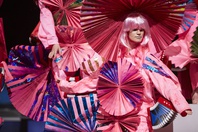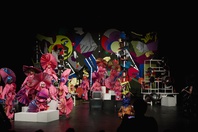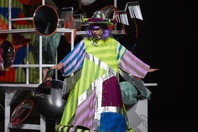Justene Williams
Sydney
2017
Displayed 2017 at Carriageworks

Justene Williams
Born 1970, Sydney. Lives and works Sydney
Justene Williams’ amalgamation of video, photography, sculpture and performance calls upon dada techniques of collage and the absurd, utilising historical and pop-culture references in order to re-examine forgotten imagery. Using found and recycled materials, Williams creates elaborate costumes and environments in which she executes delirious, shamanistic actions that channel the visual excesses of the early-20th century avant-garde, as well as alluding to more cryptic personal narratives. Documented performances are collaged and screened within complex, high-energy environments, which are experienced as immersive cacophonies of performance, sculpture, video and sound.
Artist text
by Alex Gawronski
Justene Williams’ work for The National 2017: New Australian Art extends her interest in the legacies of the modernist avant-garde. Here, Williams’ reference is to Italian futurist artist Fortunato Depero. In 1916 Depero planned a multi-media performance titled Misamagia, a hypothetical event that intended to engage a complex simultaneity of forms, colours, onomatopoeia, sounds and noises. Like his futurist colleagues, Depero valorised principles of speed, dynamism, flamboyance and danger, in keeping with the futurist embrace of modern technologised reality. To date, Williams’ own work has readily embraced these principles, making Depero’s unrealised spectacle perfect material for the contemporary artist.
By no means merely staging Depero’s instructions, Williams actually deconstructs them. The result, then, is no simple (re-)enactment but a critical reconsideration of modernist artistic intentions. The futurists, like most modernist avant-gardes, aimed to change the world directly. They wanted to create an art of the future that would equally shape that future. In the futurists’ case, shaping the future meant embracing Mussolini’s fascist reconstruction of Italy. In the end, the ultimate estrangement of futurists and fascist dictatorship only highlighted the core irreconcilability of their respective visions.
Physically and conceptually, Williams’ is an ambitious work. It includes a series of three-metre-high pole-like fake trees interspersed across the gallery space. Various singers vocalising long vowel sounds climb these trees at intervals. Sound literally ascends and descends with the performers. Elsewhere, hip-hop singers inflect the experimental feel of the show with an expressly contemporary sensibility. Fan dancers wear costumes into which accordions have been sewn, making each of their movements sonic: the performers’ own bodies become musical instruments. Through large painted scenic curtains into which holes have been cut, other singers poke their heads. They wear the apparatus of the stage as if it were a costume. Williams’ performance/installation celebrates the avant-garde dream of a total artwork (gesamtkunstwerk) while domesticating it. The work revels in energetic ritual over theoretically inflated grandiosity.
Underlying Williams’ work overall is a sense of absurdity and play. Certainly this was not entirely missing from the futurists’ original outlook. Williams, however, deliberately pursues these traits to hyperbolic lengths, undercutting the evident pretensions of the futurist world view. In fact, Williams’ work saves Depero’s extravaganza from itself by focusing concretely on the dynamics of staging, costuming, movement and sound, and on the real-time interaction of bodies in space. Bodies, for futurism, almost exclusively meant male bodies in an artistic movement almost wholly dominated by men. Williams’ reimagining of Depero’s work thus makes such a reimagining an irreverent act in itself. To discuss irreverence though does not discount Williams’ distinct admiration for the essence of the original. Such admiration is clearly evident in the artist’s sheer attention to costume and staging detail, the quality of sound and the interplay of both professional and amateur performers and musicians. Here, Williams creates a new world from which modernism is reborn as a vital component of an art of today’s future. The contemporary artist draws brand new lessons from the modern art of a (by now) distant past.


